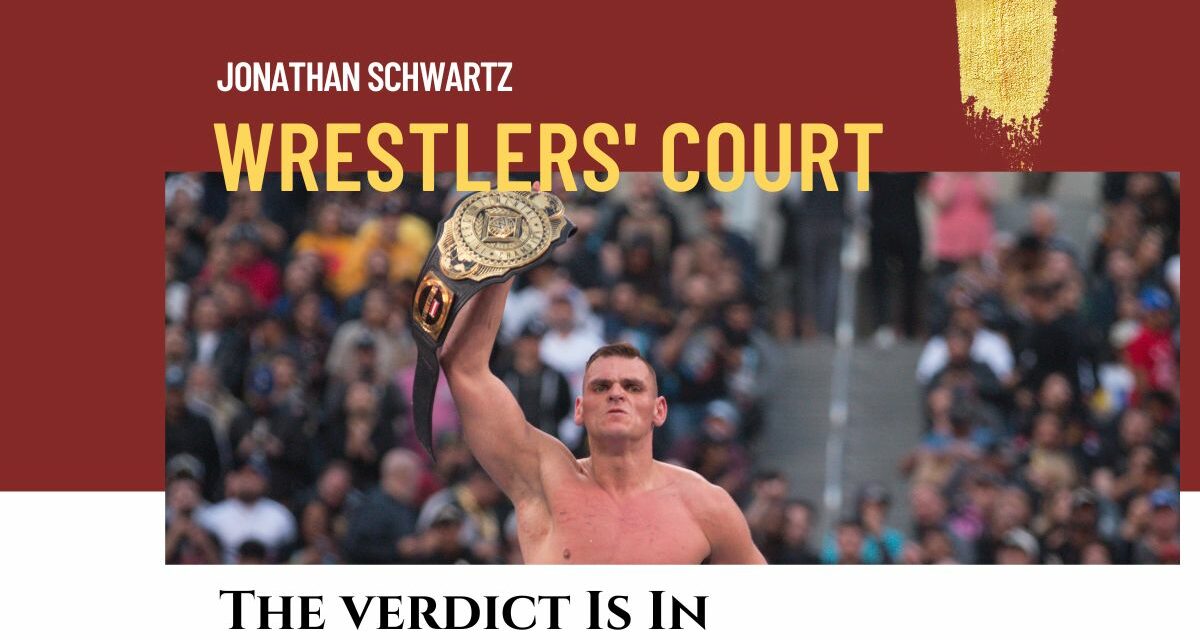On September 7, WWE saw one of its longstanding records fall. Current Intercontinental Champion Gunther retained his title against perennial mid-carder Chad Gable in a spirited match, guaranteeing by virtue of his schedule that he would eclipse the Honky Tonk Man’s (HTM) 454-day reign as champion.
Gunther shows no signs of slowing down. He has been a dominant champion at 491 days and counting. I like him better for his work in the ring than his promos and storylines outside of it, but I think that as a self-serious bruising heel he is a good standard bearer for what is widely seen as WWE’s ‘workhorse’ title. He’s certainly a better fit than the previous record holder, who would be considered a comedy footnote in the annals of wrestling but for his own title run.
I’ll discuss their relative merits later.
Gunther’s record has been hyped extensively on RAW and SmackDown… and I can see why. HTM’s record stood for 35 years. HTM was the 12th Intercontinental Champion (and the next three longest reigns belonged to Pedro Morales, Randy Savage and Don Muraco — all of which took place in the 1980s). According to Wikipedia, Gunther is the 183rd champion. So lots has happened between HTM’s day and now. A new record makes more sense when one considers that HTM has routinely courted controversy since his time with the WWF ended. It also reflects a more recent trend in WWE with longer title reigns used as a way of solidifying top acts. Further, it reflects a shift in booking philosophy away from car crash TV and frequent crowd-popping title changes and towards more productive, slow-burn storytelling.
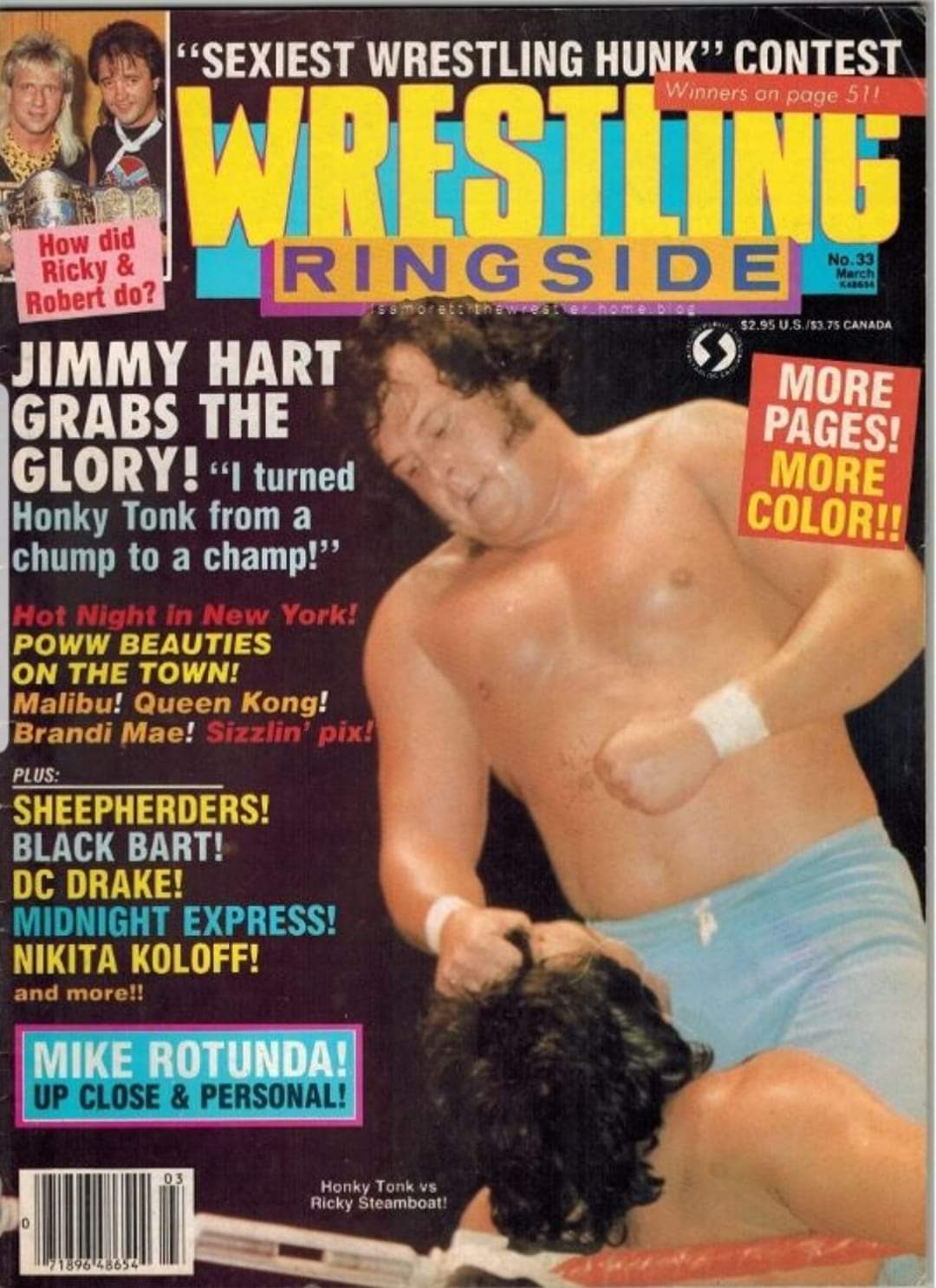
Honky Tonk Man on the cover of Wrestling Ringside in March 1988.
While Gunther has been quick to proclaim himself the Greatest Intercontinental Champion of All Time, the former GICAT has argued that his run was superior. Gunther shows up to defend his title on TV and occasionally on house shows, but this schedule is nothing compared to the WWF touring machine of the 1980s. A quick internet search suggests that as of September 23 Gunther defended his title a total of 15 times. Compared to the schedule described in the documentary 350 Days that’s plausibly less than a month of defenses (mostly count outs and disqualifications) for HTM.
At some point it feels silly to talk about pro wrestling records. After all, winners and losers are predetermined and the length of a title run is more of a reflection of the office’s belief in a wrestler as a box office draw than in their ability to win a fight. Then again, arguments about an athlete’s place in the record books happen all the time in ‘real’ sports as well. Major League Baseball leads this field ever since Roger Maris dethroned Babe Ruth as Home Run King, only for detractors to insist that his record reflect the longer season he played. Subsequent records by the likes of Barry Bonds, Mark McGwire and Sammy Sosa have been ignored (and their bids for the Hall of Fame quashed) over allegations that they cheated by using performance-enhancing drugs. It’s as arbitrary as Jack Tunney ‘firing’ Rick Rude for insulting the Big Bossman’s mother. Roger Clemens is excluded from the record books over his alleged PED use. Pete Rose is banned from the Hall of Fame for gambling (and other infractions). Gaylord Perry threw an illegal spitball and everyone knew it, yet he’s in the Hall of Fame. Alex Rodriguez was suspended for a full year over his PED use, but he was welcomed into the Hall in 2022. Ty Cobb was a bully and a cheat and according to some a walking hate crime. He’s in too. As a pro wrestling fan I’ll stay silent on that issue, except to say that I don’t see how steroids help one hit a curveball.
More broadly, new records are often challenged by old fans who argue that their heroes were better athletes despite advances in nutrition, training, rule changes and broader societal innovations like electric lighting for night games, integration, immigration or enclosed stadiums in frozen tundra. All records reflect at least a little bias and revisionist history. I dislike how much ink is spilled in sportswriting and commentary about chasing records and statistics. It turns sport into math class. I became a lawyer to avoid that.
Brief rant over.
Pretty much any rasslin’ record exists in a field of asterisks. Pro wrestling records exist in an atmosphere of unreality. Apart from the fact that nobody really ‘wins’ or ‘loses’ anything, start and end dates are notoriously fluid. Matches may be taped weeks or months in advance. Titles can be fabricated and awarded out of thin air (or however thick the air is in Rio de Janeiro). Championship wins and losses can be retconned out of existence, fusing multiple shorter reigns into single longer ones.
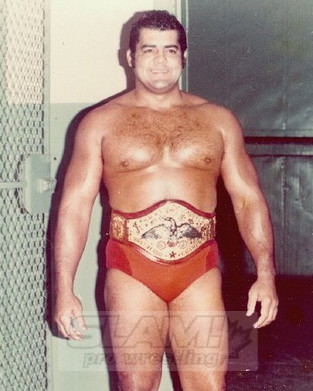
Pedro Morales as the WWWF champion. Chris Swisher Collection
Promotions aren’t known for having long memories. WWE markets John Cena and his 16 title reigns as the Greatest of all Time, even though combined he has been champion about half as long as Hulk Hogan or Bob Backlund, and barely longer than Pedro Morales (who ‘only’ held the WWF championship once, albeit for almost three years). Until Cena formally retires fans will wonder if he beats Ric Flair’s WWE-sanctioned record of 17 world championships-which is itself acknowledged by many as drastically under-counted.
Roman Reigns has fewer total reigns but he’s going strong at 1,200+ days and counting as Undisputed Universal Champion (although that title, like most post-Attitude Era is readily disputable given repeated brand splits and consolidations). Reigns has worked a light, ‘big fight heavyweight’ schedule for years. Since he started his current run he has defended his title only 28 times. I allow that the number of days is impressive, but the number of times Reigns has actually worked is nothing compared to the grueling schedule of a touring champion like Ric Flair, a fighting brand ambassador like Hogan or Bret Hart, or a pre-international expansion titlist like Bruno Sammartino, who worked a tighter loop of Northeastern US and Canadian cities, but still managed multiple title defenses per week.
I can see Reigns passing Backlund and Hogan on the list, especially given his lighter schedule and Hogan’s sullied reputation, but Sammartino’s reign is likely untouchable. I find it difficult to believe that WWE and its audience would ever countenance the same person on top for a decade (or three, if you want to throw the Fabulous Moolah into the mix). WWE will more likely do what it always does: ignore the inconvenient truths within a business built on fiction. WWE has already subtly started positioning Reigns as the longest-reigning champion by pretending they didn’t exist before WrestleMania. Conveniently this ignores Sammartino, Backlund and Morales and lops off the early part of Hulkamania.
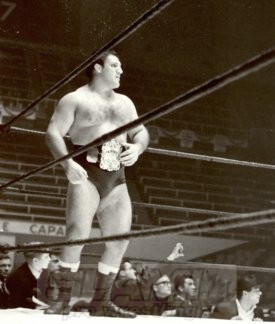
WWWF World champion Bruno Sammartino in Toronto. Photo by Roger Baker
Problem solved, unless you happened to buy tickets to watch these men fight in their prime, and it’s still real to you.
Damnit.
I’ll declare my own biases: In this column I’ll limit my comments mostly to the WWWF/WWF/WWE largely because of its early adoption of a more professional approach to booking. While the McMahon family paraded its pre-Endeavor small business credentials, it’s important to note that for the most part they stayed out of the ring. Core talent including champions were kept under contract but (unless Dave Meltzer knows something I don’t) the only wrestlers who owned a small part of the territory were Gorilla Monsoon and Arnold Skaaland — and they were quickly bought out when Vincent K. took over.
As a straightforward business, it seems unfair to compare New York to the sprawling NWA, which comprised a host of regional promotions, some of which (like St Louis or Houston) were run by independent legitimate businessmen; others were run by less legitimate businessmen and many were run by outright carny pro wrestlers themselves.
One can imagine a different approach to booking when the same person signs the checks and decides who main events. There were many successful family-run territories including the Armstrongs, Rougeaus, Harts, and Fullers… but the pressures imposed by limited geography, tight budgets and the trust that comes with keeping it in the family make it unfair to include promotions like the AWA or WCCW or Memphis Wrestling in the conversation. These promotions’ longest reigning or most multiple champions tended to be the promotions’ owners, family members or close friends by necessity. For a promotion to stay in business for decades is still a feat, and championship records are fun footnotes, but the different business models make comparisons difficult.
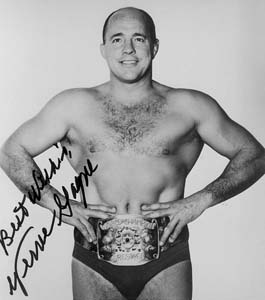
Verne Gagne
AWA owner Verne Gagne notched himself 10 AWA World Heavyweight championship reigns totaling 4,677 days. He retired from active competition as champion rather than put over new talent.
Fritz von Erich took over World Class Championship Wrestling headquartered in Dallas, in 1966. He would hold that title 20 times and retire immediately after winning it for the last time. Sons Kerry, Kevin and Mike von Erich would combine for another 16 reigns.
Jerry Lawler claims to have held more recognized wrestling championships than any wrestler in history. The vast majority of these reigns happened in his home Memphis territory. Lawler is a 58-time AWA Southern Tag Team champion and crowned himself USWA champ 28 times for a total of 1764 days. His next closest rival was Sid Vicious, who only managed two reigns totaling 208 days (although I guarantee you if squeegees were legal, those numbers would be different).
Otherwise, WCW is long dead and, having made the transition from Crockett to Corporate ownership decades before WWE merged into TKO, their booking decisions were often suspect. The jury is out on AEW, which is only four years old. Bob Backlund, Hulk Hogan, Pedro Morales and Bruno Sammartino’s title reigns lasted longer than AEW has been extant.
As noted up top, the most recent record to fall is the Honky Tonk Man’s Intercontinental Championship run, which was eclipsed by current titlist Gunther in September 2023. Gunther had previously established himself as a long-reigning champion. Perhaps aided by the COVID-19 pandemic, Gunther (then known as Walter) was the longest-reigning NXT UK Champion before he joined WWE’s US roster-and one of several NXT UK stars who survived the shuttering of that brand. Gunther/Walter won the NXT UK championship in 2019, ending Pete ‘Butch’ Dunne’s own longstanding title reign. Gunther’s NXT UK title defenses included matches against Tyler Bate and current NXT champion Ilja Dragunov that broke the Dave Meltzer star system. He would hold this title for 870 days, before losing to Dragunov.
Gunther joined SmackDown in April 2022. By June, he beat Ricochet for the Intercontinental Championship and has kept a stranglehold on it ever since. Gunther’s victory over Ricochet would establish a winning formula: a slow start, a mix of technical wrestling and brawling. A whole bunch of really loud chops, and occasionally surprising displays of power and agility. Gunther’s a big guy. He stands 6-foot-4 and currently weighs just shy of 300 pounds. He has also transformed himself physically. Until he arrived in the US he looked like a standard superheavyweight — one of his early ring names on the independent scene was ‘Big Van Walter’. He has slimmed down and added considerable muscle. He’s no bodybuilder, which I consider a good thing-it makes him stand out and adds credibility as a fighter. He looks every bit the archetypal heel pro wrestler. Like most fit, rangy wrestlers he reminds me a bit of Killer Kowalski in appearance — but with a more high-impact repertoire.
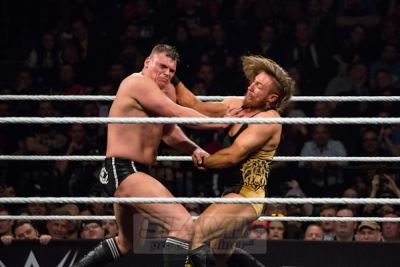
Walter against Pete Dunne in NXT at WrestleMania 35. Photo by Ricky Havlik
Gunther’s matches vary by opponent but share a common theme: he rarely outright destroys his foes — he’s had relatively few squash victories-but he does thrash them soundly. To date, Gunther’s victims include Ricochet, Shinsuke Nakamura, Rey Mysterio, Braun Strowman, Xavier Woods, Otis and the recently-released Mustafa Ali, Matt Riddle and Madcap Moss. He has moved from SmackDown to Raw and remained dominant. Perhaps foreshadowing his entry into the World title picture, Gunther entered the 2023 Royal Rumble at number one. He would go bell-to-bell before being tossed out by eventual winner and number 30, Cody Rhodes. Gunther’s most recent feud (which is still being teased by his challenger) has been Chad Gable, who is being positioned as an underdog despite spending much of his career in tag teams or just plain losing.
The problem with Gunther’s reign compared to the Honky Tonk Man’s is that Gunther so clearly overmatches his opponents. Since winning the title Gunther has been booked as unstoppable, mowing down a series of babyfaces (and the occasional heel, like Bronson Reed).
The Honky Tonk Man’s reign was entertaining precisely because he had no business holding that belt. His initial victory over Ricky ‘The Dragon’ Steamboat following Steamboat’s classic WrestleMania III victory over ‘Macho Man’ Randy Savage was a real shock. Steamboat fought an incredible, evenly contested classic Savage. It still ranks among the best WrestleMania matches of all time. With all due respect to the Honky Tonk Man, I don’t think his matches would win any awards except for fewest bumps taken (and that’s fine, he worked safe and escaped serious injury during his career). Even then, HTM had to cheat his way to victory, illegally grabbing the ropes during an inside cradle reversal. HTM’s victory took less than six minutes. It aired on WWF syndicated Saturday morning programming, a far cry from the kayfabed 93,173 fans who witnessed Steamboat’s victory at the Pontiac Silverdome.
HTM was a literal throwback: a gimmick that was stale on arrival and made funny by the performer’s refusal to acknowledge its source material — he famously plead ignorance whenever Elvis Presley’s name would be mentioned). If you’re around my age you may remember his WWE debut. In the summer of 1986 The Honky Tonk Man (Wayne Ferris) first appeared as a babyface on a ‘Body Shop’ segment hosted by Don Muraco. He would be linked to popular stars like the Junkyard Dog and receive the blessing of a Hulk Hogan promo in his favor. HTM would challenge heels like Paul Orndorff, Randy Savage and Jake ‘The Snake’ Roberts. Whether this gimmick was designed to fail or it just sucked, HTM bombed as a babyface. His run might have been a WrestleCrap footnote if the WWF hadn’t recast him as a heel; first through a series of segments with Jesse Ventura and then through a request for a fan “vote of confidence” which saw HTM insult his audience like his cousin’s favorite opponent, Andy Kaufman. Having failed to win the fans’ support, HTM would officially turn heel and take ‘Colonel’ Jimmy Hart on as his manager.
One wonders what would have happened if this sort of gimmick were used today. In pro wrestling and other media, leaving decisions in viewers’ hands can have unanticipated results. A few years after HTM’s ‘vote of confidence’ the creative team behind Batman comic books would leave the fate of Jason Todd-Batman’s sidekick, Robin, to readers in a vote.
Robin would die.
Also, Donald Trump became President.
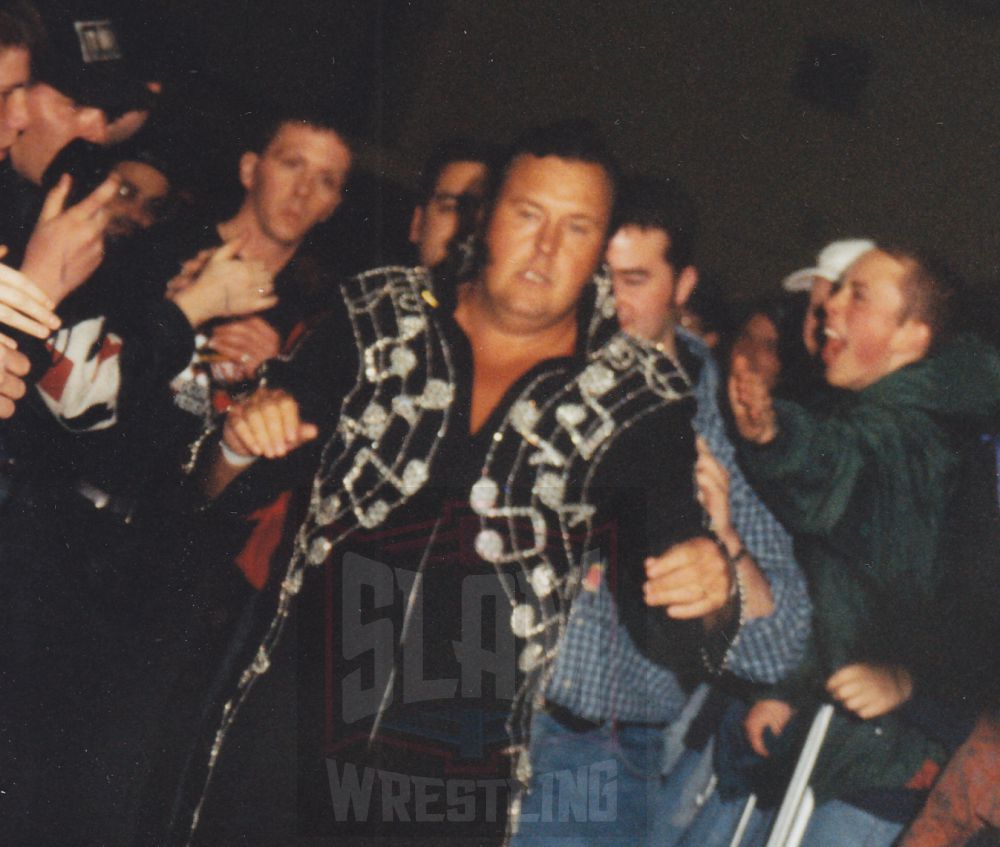
The Honky Tonk Man heads to the ring in the WWF, for a show in London, Ontario. Photo by Terry Dart
HTM worked as champion precisely because in any feud he was so obviously overmatched. As Vince McMahon emphasized bigger than life bodybuilders, HTM was anything but. Billed at 6-foot-1 (including duck’s ass hairdo) and 243 pounds, he was never an ICO/PRO spokesman. His move set ran to basic heel punching and kicking and cowardice, and his finisher was a generic swinging neckbreaker turned lethal by shaking his hips. HTM’s propensity to bail on title defenses or get disqualified introduced a heightened sense of drama whenever he entered the ring. It seemed like just about anyone could beat him, and most came perilously close. At a time when world championship reigns were measured in years, and with the tag team titles locked down by Demolition, the prospect of seeing an actual title change was catnip to an impressionable fan. The fact that the Honky Tonk Man escaped was maddening. He robbed us of a fan favorite celebration. His matches may not have rated on the Meltzer scale, but if professional wrestling is about storytelling-eliciting real emotions by fake-fighting, I can’t think of many who did it better.
As an adult I see how much goofy fun he was.
As a kid, I hated his guts.
I hated him even more as he embarked on his improbably long Intercontinental Championship run. Legend has it that this run owes more to circumstance than successful long-term planning. Steamboat was primed for his own long run as Intercontinental Champion after beating Savage, but a request for time off after his wife gave birth rubbed Vince McMahon the wrong way. Steamboat got his time off at the expense of his WWF push, and ultimately his career. He was originally supposed to drop the title on TV to ‘The Natural’ Butch Reed, but Reed allegedly no-showed the tapings (although Reed is clearly seen in in the locker room, celebrating HTM’s win with other heels… which may speak more to clever editing than actual history). Even then, HTM was intended to be a transitional champion between Steamboat and now fan favorite Jake Roberts, who was slated to win the Intercontinental championship at WrestleMania III. Roberts’ substance abuse issues meant HTM retained, and a friendly word from Hulk Hogan to Vince McMahon gave HTM his shot at a long reign. At one point a babyface Randy Savage was slated to relieve HTM of his title. That fell through, too — and Savage would win his first World’s championship at WrestleMania IV as a salve to his ego (mind you, that didn’t help Ted DiBiase, who was supposed to win the belt originally, but that’s a story for another day).
HTM regularly abused what we now call the ‘champion’s advantage’: the rule that a title may only change hands via pinfall or submission. HTM regularly lost matches deliberately, via count out or disqualification. If WWF ring announcer Howard Finkel is best remembered for hailing title changes with the words “AND NEEEEEEWWWWW”, his post-match explanation that the title did NOT change hands following a Honky Tonk match should also be part of his legacy. HTM fought, lost and retained his title against everyone from Steamboat and Roberts to Billy Jack Haynes (who had earlier seen his championship dreams thwarted by Randy Savage and ‘Dangerous’ Danny Davis), George ‘The Animal’ Steele, good guy Randy Savage and an un-retired Bruno Sammartino, who was mortally indignant over HTM’s lack of fair play (Doggone it!). HTM’s last high profile feud as champion would come against Brutus ‘The Barber’ Beefcake. The two men started feuding at WrestleMania IV, when HTM again got himself disqualified to save his title and were scheduled for a rematch at the 1988 SummerSlam, when Beefcake was written out — diverted into a feud with ‘Outlaw’ Ron Bass — and HTM’s arrogance would get the better of him. After issuing an open challenge to the locker room, the Honky Tonk Man would lose his belt faster than he’d won it, getting steamrolled by the Ultimate Warrior in his own meteoric push. The Greatest Intercontinental Champion of All Time would lose his title in 31 seconds. He never even got to remove his jumpsuit. All told, he reigned for 454 days.
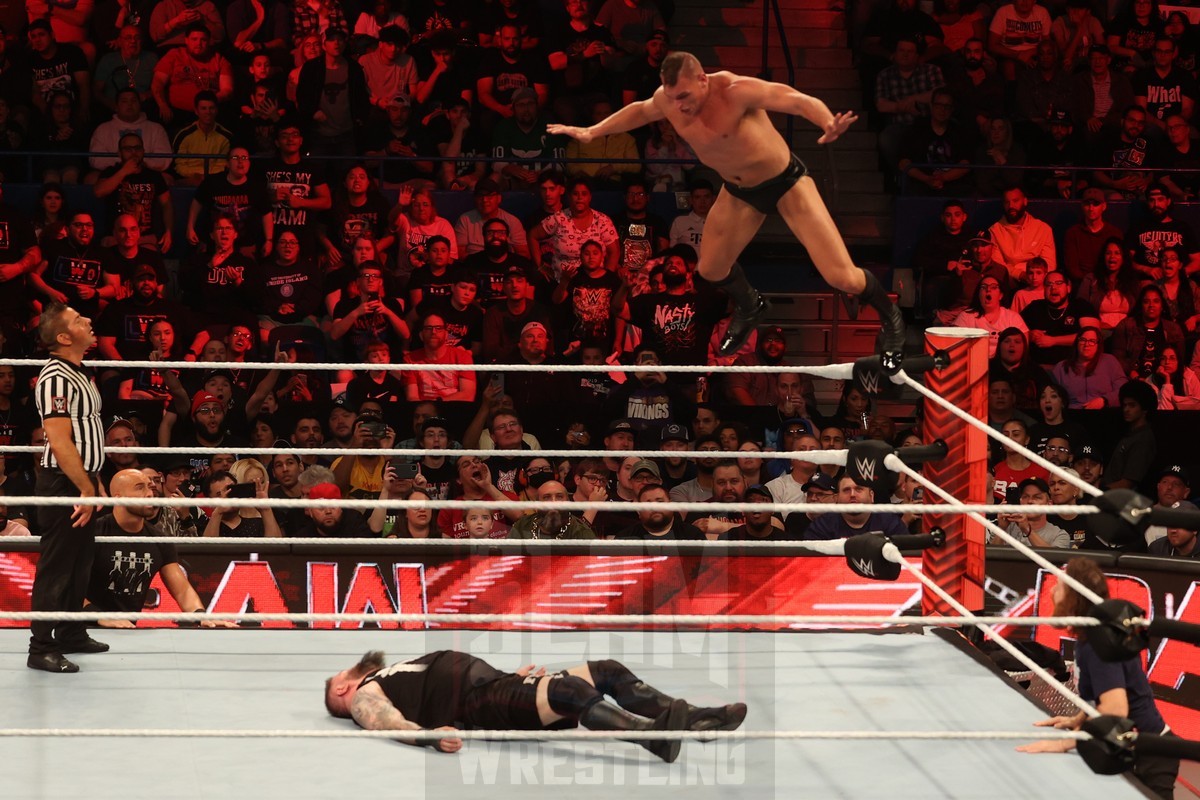
Kevin Owens Vs. Gunther at WWE Monday Night Raw, at XL Center, in Hartford, CT, on Monday, June 5, 2023. Photo by George Tahinos, https://georgetahinos.smugmug.com
Gunther’s championship reign has produced several solid matches, including some great ones against opponents of all shapes and sizes. He’s made smaller, acrobatic foes like Ricochet look good, and just last week on RAW had an absolute Hoss fight with Bronson Reed. I think his best matches as champion have come against similarly sized, tough-minded opponents like Drew McIntyre and Sheamus-serially and in combination. Gunther has also had the advantage of his Imperium subordinates to run interference…though it seems as often as not Gunther finds a way to win on his own.
Some may suggest that booking Gunther as a dominant IC Champ will pave the way for an eventual Royal Rumble win and WrestleMania main event… or at least a World Title shot and likely championship run. I think Gunther’s matches are tremendous, but in the wake of a similarly longstanding display by Roman Reigns, I think that the Honky Tonk Man’s reign was more fun. If the money in pro wrestling lies in babyface challengers going after heel titlists, Gunther’s decimation of his opponents is counterproductive. He beats his foes convincingly, so there’s no need for rematches, which means his feuds aren’t compelling.
The most intriguing part of any record is who will break it. However long Gunther’s record stands, it’s unlikely to hold out as long as HTM’s did. Demolition’s record as tag team champions stood for 26 years, from July 1989 until the New Day embarked on their 483 day run in 2015. The Usos would eclipse the New Day within six years-starting their own SmackDown run in 2021.
I’ll digress to point out that despite the fact that as heels the Usos relied heavily on interference to retain their belts, I much prefer having them as record-holders than the New Day. I thoroughly enjoyed the latter, especially in their earlier incarnation as weirdo nerd heels, but the fact that they spent most of their time as babyfaces invoking the ‘Freebird Rule’ always bothered me. For the uninitiated, the ‘Freebird Rule’ was introduced by the trio of Buddy ‘Jack’ Roberts, Michael ‘P.S.’ Hayes and Terry ‘Bamm Bamm’ Gordy as they barnstormed their way through promotions throughout the 1980s. They’re the template for every heel triumvirate that followed, featuring a guy who could talk fans into the arena (Hayes), a powerhouse (Gordy) and a technical wrestler/brawler who could work and absorb punishment while making the other team members look strong (Roberts). The Freebirds’ Southern gimmick and liberal use of Confederate Flag iconography would not be tolerated today (although it would still make them huge fan favorites in some circles, which is gross) but for the most part they were dastardly cheating heels.
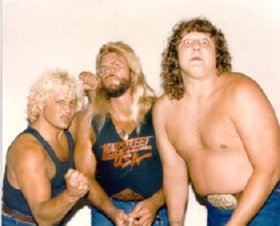
The Freebirds.
The Freebirds’ greatest innovation (for the purposes of this column) was their eponymous rule, which states that any two members of the three-man unit can defend a tag team championship on its behalf. Within Kayfabe this offers a team using the rule a psychological and strategic advantage. From a records perspective it also means an extra body to step in and defend the titles if one member of the team is injured, needs time off, misses a flight or is hungover. It’s a great tool for heels, but a poor fit for babyfaces, and playing out the string it absolves a tag team of the most basic part of a record for longevity: the people who hold the belts need to show up to defend them. I appreciate WWE’s desire to push the New Day as they did — especially since both members of Demolition were actively suing WWE as part of Konstantine Kyros’ ill-fated class action suit at the time, but their record always felt hollow to me. The Usos did wrong, but they cheated the right way.
The Usos’s reign yielded some great tag team matches, but its biggest value was in the fodder it provided for the Bloodline saga, culminating in a WrestleMania main event loss to Kevin Owens and Sami Zayn.
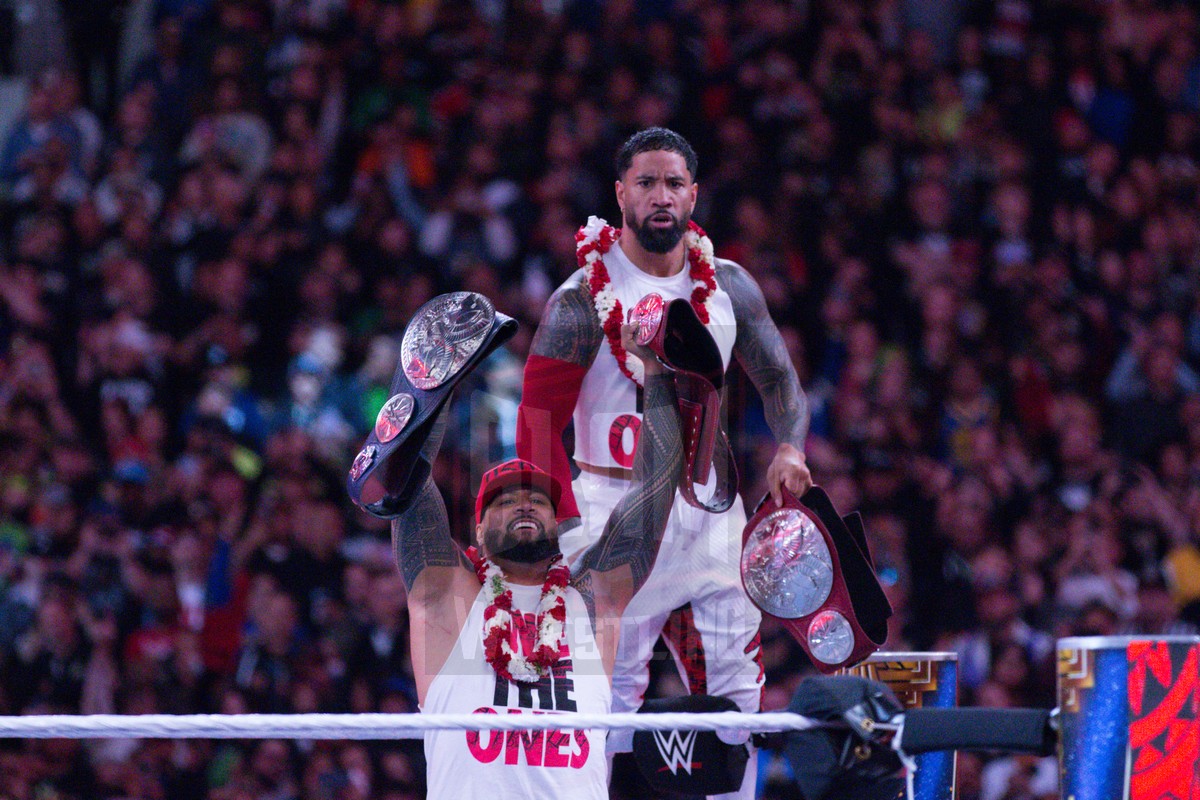
Jimmy & Jey Uso at Night 1 of WrestleMania 39 at SoFi Stadium in Inglewood, California, on Saturday, April 1, 2023. Photo by Steve Argintaru, Twitter: @stevetsn Instagram: @stevetsn
I loved that storyline and would have hoped for Owens and Zayn to have their own prolonged run. I’ve followed both men’s careers since their days on the independent scene in Montreal, with occasional forays to the UWA in Mississauga. I was disappointed when it became clear that after such a hot feud, Owens and Zayn had nowhere to go but down. They defended the titles successfully in rematches against the Usos and in a short feud with Imperium, but in the absence of a lively tag team division it was clear they wouldn’t be on top for long. Still, they deserved better than to lose to Finn Balor and Damien Priest’s Judgment Day tandem (who also deserved better than a flash loss to Cody Rhodes and Jey Uso). But as RAW has shifted focus to Uso and Rhodes the writing was on the wall. Not only would Owens’ and Zayn’s tag team run prove disappointingly short, the team would be disbanded this past week on SmackDown, with Owens being ‘traded’ for Jey at Cody Rhodes’ behest.
Apart from the fact that this all makes Cody look like a sublimely manipulative heel getting rid of prospective competition, it leaves Zayn unprotected as a babyface and without a clear creative direction other than his post-Bloodline ‘frenemy’ status with Jey. I smell an eventual heel turn, but first it’s worth noting that Zayn is back to being a crowd pleasing underdog from the underground.
And who better to beat an Ubermensch like Gunther than an Underdog?
TOP PHOTO: Intercontinental champion Gunther at Night 2 of WrestleMania 39 at SoFi Stadium in Inglewood, California, on Sunday, April 2, 2023. Photo by Steve Argintaru, Twitter: @stevetsn Instagram: @stevetsn
RELATED LINK
